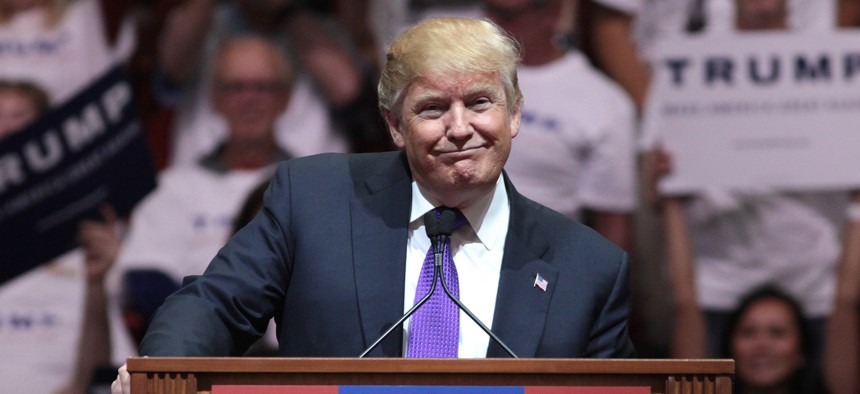
Flickr user Gage Skidmore
Polls: Tight Race Developing Between Clinton, Trump
A group of new polls released Tuesday shows a surprisingly close race between Hillary Clinton and Donald Trump.
Warning: Candidates in this election may be closer than they appear.
To listen to the handwringing from despondent Republicans and the self-assurance from exultant Democrats over the last week, a Hillary Clinton landslide defeat of Donald Trump in November seemed a fait accompli. On Tuesday morning, however, the release of a group of polls put a damper on that forecast—at least for a few hours until the next ones come out.
The swing-state surveys from Quinnipiac University and a national snapshot from Public Policy Polling, a left-leaning firm, show a surprisingly close general-election race. The PPP survey found Clinton leading Trump by just four points nationally, 42 percent to 38 percent, while Quinnipiac found the two essentially tied in Florida, Pennsylvania, and Ohio. Trump edged Clinton by four points in the Buckeye State, and Clinton led him by a point in Florida and Pennsylvania. As with any poll taken six months before the election, these require a couple grains of salt, and in the case of Quinnipiac, perhaps a few more. Other political forecasters pointed out that its sample of voters in the three states was more white than in 2012 exit polls, while the electorate is expected to be similar in 2016 if not more diverse than four years ago. A sample with more white voters would favor Republicans.
Still, both sets of data point to a tighter contest than other recent polls and far closer than the congealing conventional wisdom would suggest. A CNN/ORC national survey released last week gave Clinton a 13-point advantage, and the RealClearPolitics average has her up by more than six points. Polls that show Clinton leading Trump by nine points in North Carolina and down by just one in traditionally Republican Georgia contributed to the impression that the campaign was over before it started.
Polls across the board show that both Clinton and Trump are historically unpopular for major-party nominees, and Clinton’s advantage has come from data finding that voters like Trump less than her. Republicans also appear far more divided than Democrats, and the refusal of GOP leaders like House Speaker Paul Ryan to embrace Trump would seem to undercut his ability to unify the party against Clinton.
Or maybe not.
The key to the PPP result is that just as rank-and-file Republicans have bucked the establishment’s choices for the last year, they may be reconciling themselves to Trump’s nomination faster than their leadership, as well. Trump led Clinton 78 percent to 7 percent among Republicans, and nearly three-quarters of GOP respondents said they were comfortable with him as their standard-bearer. “Although much has been made of disunity in the GOP, it is actually just as unified behind Trump as the Democrats are behind Clinton,” PPP’s Tom Jensen wrote in his analysis. The PPP survey included minor-party candidates Gary Johnson of the Libertarian Party and Jill Stein of the Green Party. When they were excluded, Clinton’s lead grew to six points—in line with the national polling average.
The biggest warning sign for Clinton is that as toxic as Trump has proven for women and minorities, Clinton herself is nearly as disliked by white men. In Florida, just 25 percent of white men went for Clinton. Bernie Sanders continues to fare better overall against Trump nationally and in Ohio and Pennsylvania, despite his losses to Clinton in the Democratic primaries there. In the PPP poll, a “generic” Democrat performed better against a generic Republican than Clinton did against Trump.
What, if anything, do these polls say about the race? The Quinnipiac surveys could be outliers, or they could be capturing an electorate that skews older and whiter than the voters who will show up in November. Or they could be showing a Trump bump in the days after his last rivals dropped out of the GOP race. The Democrats’ structural advantage remains—but so does the disadvantage of having an unpopular candidate atop the party’s ticket.
If you had to pick, you’d still rather be Clinton heading toward the fall. Just don’t assume a landslide quite yet.
(Image via Flickr user Gage Skidmore)






